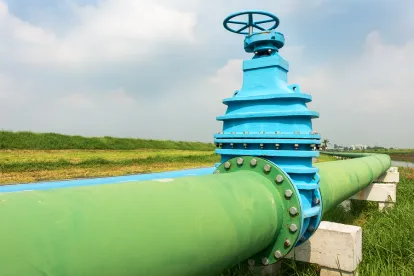PHMSA Issues Draft FAQs Addressing Regulatory Oversight at Midstream Processing Facilities
On November 4, the Pipeline and Hazardous Materials Safety Administration (PHMSA) issued a Notice and Request for Comments (Notice) on draft frequently asked question (FAQs) providing guidance on how the PHMSA and the Occupational Safety and Health Administration (OSHA) delineate their inspection and enforcement responsibilities at “midstream processing facilities” when the authorities of the two agencies overlap. Comments on the draft FAQs are due January 4, 2021.
What is a “midstream processing facility”? The term “midstream processing facility” is not defined in the Pipeline Safety Laws or the regulations of PHMSA or OSHA. The Notice states that, for purposes of the draft FAQs, a midstream processing facility “receives products being transported by PHMSA-jurisdictional pipelines and re-injects those products for continued transportation by pipeline. In other words, a midstream processing facility is a processing facility with piping or storage that is engaged in the transportation of gas or hazardous liquids by pipeline, and is therefore a pipeline facility subject to PHMSA jurisdiction.”
The Notice states further that, for purposes of the draft FAQs, “processing” is “the treatment of products including, but not limited to dehydration, removal of contaminants by separation or filtration, blending with other products, and heating or cooling units that separate or purify products and remove condensates by distillation.” Processing would not include facilities used for the “chemical conversion of crude oil into refined petroleum products,” which the draft FAQs state are refining facilities. The draft FAQs would define a “processing facility” as one or more individual units that perform a processing operation and meet the criteria specified in OSHA’s process safety management (PSM) regulations (29 C.F.R. § 1910.119).
What is the purpose of the draft FAQs? The Notice states that, depending on the purpose and configuration of a midstream processing facility, the pipeline systems within or associated with such a facility may be subject to regulation by one or more federal agency. According to the Notice, the transportation-related pipeline systems associated with a midstream processing facility are subject to Parts 190-199 of PHMSA’s regulations and OSHA regulates safety within the facility under its PSM regulations. The Notice explains, however, that uncertainty exists regarding the beginning and end of each agency’s authority, resulting in confusion and duplication of regulatory efforts.
To improve safety, enhance clarity, and eliminate unnecessary gaps and overlap in federal safety oversight, the Gas Pipeline Advisory Committee (GPAC) and Liquid Pipeline Advisory Committee (LPAC), which are advisory committees created under the Pipeline Safety Act to advise PHMSA on proposed pipeline safety standards, established a Working Group in 2014. The Working Group, which included representatives of PHMSA, OSHA and the industry, was directed to evaluate the equivalency of PHMSA and OSHA safety requirements for midstream processing facilities, identify a method of delineating regulatory oversight responsibilities between the two agencies, and address the oversight of midstream processing facilities containing pass-through, bypass, and storage configurations, including storage-related piping.
The Working Group concluded that the regulations of PHMSA and OSHA provide equivalent safety at midstream processing facilities, but that enforcement of both sets of regulations created unnecessary contradictions and confusion potentially detrimental to safety. As explained at an August 26, 2015 Joint GPAC/LPAC meeting, the Working Group proposed seven FAQs to clarify the delineation of regulatory oversight responsibilities of the two agencies.
What do the draft FAQs do? The Notice states that the draft FAQs reflect agreement between PHMSA and OSHA to delineate where they will exercise their regulatory oversight activities at midstream processing facilities without modifying each agency’s statutory authority over such facilities. Draft FAQ #1 proposes definitions of the terms “processing” and “processing facility.”
Other FAQs (reproduced below) describe how PHMSA and OSHA will regulate facilities in bypass configurations, at complex facilities with multiple processing units, and at gas storage systems and identify upstream and downstream demarcation points between PHMSA-regulated pipeline transportation facilities and OSHA-regulated processing facilities.
FAQ #2: How does one delineate the boundary between pipeline transportation and a processing facility? PHMSA policy indicates that, in deference to OSHA’s exercise of its authority, it will not conduct inspection and enforcement activities (“regulatory oversight activities”) under 49 C.F.R. part 192 and 195 for pipelines downstream of the first pressure control device entering a processing facility, and upstream of the last pressure control device leaving that processing facility, except as described in provisions of FAQ 4.
FAQ #3: How does PHMSA’s policy apply to regulatory oversight of a pipeline entering a processing facility that bypasses a pressure control device? A pipeline that predominantly (more than 50% of the time during the preceding calendar year) bypasses a pressure control device will be subject to PHMSA regulatory oversight activities under 49 C.F.R. part 192 or 195. Further, if a pipeline bypasses a pressure control device that is permanently no longer in service, the pipeline will be subject to PHMSA regulatory oversight activities under 49 C.F.R. part 192 or 195.
FAQ # 4: How does PHMSA’s policy apply to regulatory oversight of piping that bypasses processing downstream of the first pressure control device? Piping that is downstream of the first pressure control device that is not predominately (more than 50% of the time during the previous calendar year) used to bypass processing will be subject to regulatory oversight activities by OSHA under its’s process safety management regulations. Piping that is downstream of the first pressure control device that is predominantly (more than 50% of the time during the previous calendar year) used to bypass processing will be subject to PHMSA regulatory oversight activities under 49 C.F.R. part 192 or 195.
FAQ #5: What if a given section of piping located on the grounds of a processing facility served by PHMSA-regulated pipelines connects two processing units or is otherwise used for a processing function? If the piping is located downstream of the first pressure control device entering the facility and upstream of the last pressure control device leaving the facility, it would be subject to regulatory oversight activities by OSHA under its process safety management regulations. PHMSA policy indicates that in deference to OSHA’s exercise of its authority, this section of piping would not be subject to PHMSA regulatory oversight activities under 49 C.F.R. part 192 or 195.
FAQ #6. How is underground storage and associated piping located on the grounds of a processing facility regulated? Piping associated with underground storage used for the ‘‘purpose of managing processing facility inventory’’ will be subject to regulatory oversight activities by OSHA under its process safety management regulations. Piping associated with storage caverns used for transportation will be subject to PHMSA regulatory oversight activities under 49 C.F.R. part 192 or 195. Additionally, underground natural gas storage facilities, as defined in §192.3, must comply with the applicable reporting requirements in 49 C.F.R. part 191 and underground natural gas storage safety requirements in §192.12.
FAQ #7. How are pipelines connecting storage or processing facilities regulated when traversing public or private lands (outside the grounds of storage or processing facilities)? Pipelines exiting a pressure control device of storage or processing facilities and traversing public or private lands outside the grounds of storage or processing facilities will be subject to PHMSA regulatory oversight activities under 49 C.F.R. part 192 or 195.
The Notice states that, in order for the FAQs to apply to a facility, an operator is expected to make records and documentation demonstrating the predominate use of a facility available to PHMSA and OSHA for review and verification.
Will the FAQs be enforceable? As a guidance document, the draft FAQS do not have the force and effect of law and will not be codified in the regulations of either PHMSA or OSHA. The draft FAQs instead are intended to help operators understand how to comply with the regulations. Nevertheless, the Notice states that operators who can demonstrate compliance with the FAQs are likely to be able to demonstrate compliance with regulations. An operator that adopts a different course of action must be able to demonstrate compliance with the regulations.
Status of PHMSA Rulemakings
The chart below shows the status of PHMSA’s pending pipeline safety rulemakings as reflected in (1) the Department of Transportation’s (DOT) February Significant Rulemaking Report, (2) PHMSA’s status Chart of legislatively mandated actions (updated August 18), and (3) the Office of Management & Budget’s (OMB) Office of Information and Regulatory Affairs (OIRA) Spring 2020 Unified Agenda of Regulatory and Deregulatory Actions
Pending Final Rules
|
Proceeding |
DOT Estimated Publication |
OIRA Estimated Publication |
PHMSA’s Chart |
|
Gas Pipeline Regulatory Reform |
Not Provided |
Not Listed |
Not Listed |
|
Liquid Pipeline Regulatory Reform |
Not Listed |
Not Provided |
Not Listed |
|
Safety of Gas Transmission Pipelines, Repair Criteria, Integrity Management Improvements, Cathodic Protection, Management of Change, and Other Related Amendments |
July 24, 2020 |
October 2020 |
November 9, 2020 |
|
Safety of Gas Gathering Pipelines |
July 24, 2020 |
October 2020 |
November 9, 2020 |
|
Valve Installation and Minimum Rupture Detection Standards |
Not Provided |
Not Provided |
Not Provided |
Pending Notices of Proposed Rulemakings
|
Proceeding |
DOT Estimated Publication |
OIRA Estimated Publication |
PHMSA’s Chart |
|
Amendments to LNG Facilities |
March 17, 2020 |
Withdrawn |
Withdrawn |
|
Class Location Requirements |
Published October 14, 2020 |
||
|
Periodic Standards Update Rule |
Not Listed |
June 2020 |
Not Listed |
|
Periodic Standards Update II |
Not Listed |
November 2020 |
Not Listed |
|
Repair Criteria for Hazardous Liquid Pipelines |
June 26, 2020 |
July 2020 |
Not Listed |
Pending Advance Notices of Proposed Rulemakings
|
Proceeding |
DOT Estimated Publication |
OIRA Estimated Publication |
PHMSA’s Chart |
|
Coastal Ecological Unusually Sensitive Areas |
February 20, 2020 |
June 2020 |
November 3, 2020 |
Other Updates from PHMSA
PHMSA issues stay of enforcement for pipeline and LNG operators following Hurricane Delta. On October 9, PHMSA published a Notice staying certain enforcement actions for operators of interstate gas and hazardous liquid pipelines and liquefied natural gas (LNG) facilities affected by Hurricane Delta. The Notice advises that PHMSA does not intend to take enforcement action relating to noncompliance with operator qualification requirements, personnel training requirements, or pre-employment and random drug testing requirements. The stay applies only to operators with limited resources because of the use of personnel for pipeline activities related to response and recovery. PHMSA instructs any operator that cannot comply with the above requirements to notify the PHMSA National Safety Coordinator by phone or email. The stay is effective until November 23, unless extended or rescinded.
PHMSA announces nearly $8 million in research and development awards. On October 5, PHMSA announced awards totaling $7,810,213 to fund 10 pipeline safety research and development (R&D) projects. The projects will support pipeline safety priorities including Damage/Threat Prevention, Leak Detection, Anomaly Detection/Characterization, LNG, and Improved Materials. The projects were selected by the Merit Review Panel, which consists of 28 members from PHMSA, the Federal Energy Regulatory Commission (FERC), and members of the pipeline and LNG industry.
Updates from Industry
Pipeline Safety Trust releases annual State Pipeline Safety Transparency Study. On October 28, the Pipeline Safety Trust released its annual State Pipeline Safety Transparency Study which analyzes the pipeline safety website of each state and the District of Columbia to determine how much information is publicly available and accessible to the public.
Common Ground Alliance releases 2019 DIRT Report. On October 14, the Common Ground Alliance released its 2019 Damage Information Reporting Tool (DIRT) Report. The 2019 DIRT Report states that damages to underground facilities increased by 4.5% over the previous year, reflecting an all-time high. The DIRT Report states that failure to notify the one-call center remains the largest individual damage root cause, but that the root causes are equally spread among excavation issues, locating issues, and invalidate uses of locate requests, suggesting that improvements are needed throughout the excavation process to reverse the upward damage trend. The DIRT Report contains a number of recommendations to reduce damage to buried utilities, including several recommendations addressing the identified key root causes.
Updates from Other Federal Agencies
GAO recommends FERC start assessing reliability of natural gas transmission service. On September 23, the Government Accountability Office (GAO) published a report on the reliability of natural gas transmission service. Using reports submitted to the Federal Energy Regulatory Commission (FERC), GAO found that interruptions in natural gas service without advance notice to customers occurred an average of 28 times a year from 2015-2019. GAO found that natural gas transportation was generally reliable and that interruptions in service were limited in frequency and scope, but warned that increased utilization of interstate natural gas pipelines could lead to more service interruptions in the future.
GAO also found that although FERC collects reports on serious interruptions of service, FERC does not organize the reports for easy access, or analyze the reports to identify trends or potential risks, and that consequently, FERC is not well positioned to take action to ensure reliable natural gas transportation. GAO further noted that sharing information on service interruptions could improve the Department of Energy’s and PHMSA’s efforts to understand the frequency of service interruptions and their effects. In response to GAO’s recommendations, FERC plans to establish a process to incorporate serious interruption of service reports into its ongoing efforts to monitor and address the reliability of the interstate natural gas pipeline grid.
Updates from Select States
California adopts new regulations for hazardous liquid pipelines. On October 1, California’s Office of the State Fire Marshal (OSFM) adopted new regulations requiring that hazardous liquid pipelines (including existing pipelines) located near environmentally and ecologically sensitive areas in the coastal zone use best available technology (BAT), including leak detection technology, automatic shutoff systems, remote-controlled sectionalized block valves or any combination of these technologies, based on a risk analysis to reduce the amount of oil released in an oil spill. Operators of existing pipelines must prepare a risk analysis, a risk analysis assessment, and an implementation plan by October 1, 2021, and complete retrofits by April 1, 2023.
Oklahoma adopts federal pipeline safety regulations. Effective October 1, the Oklahoma Corporation Commission (OCC) updated its pipeline safety regulations for gas and hazardous liquid pipelines to include the federal regulations as they existed on January 1, 2020. The OCC also adopted all of the provisions of Parts 191, 192, and 199 related to underground natural gas storage facilities and drug and alcohol testing.
Washington enacts new reporting requirements for gas pipelines. Beginning March 15, 2021, the Washington Utilities and Transportation Commission (WUTC) will require that gas pipeline companies submit an annual report that reflects the total number of known leaks in company-owned pipelines, the total number of hazardous and non-hazardous leaks repaired in the prior year, and the total number of leaks scheduled for repair in the following year. Under the new law, the WUTC will have discretion to determine the information requirements for the annual reports. The new law also requires the WUTC to annually publish aggregate data concerning the volumes and causes of leaks on its website and transmit the information to the state department of ecology.







 />i
/>i

